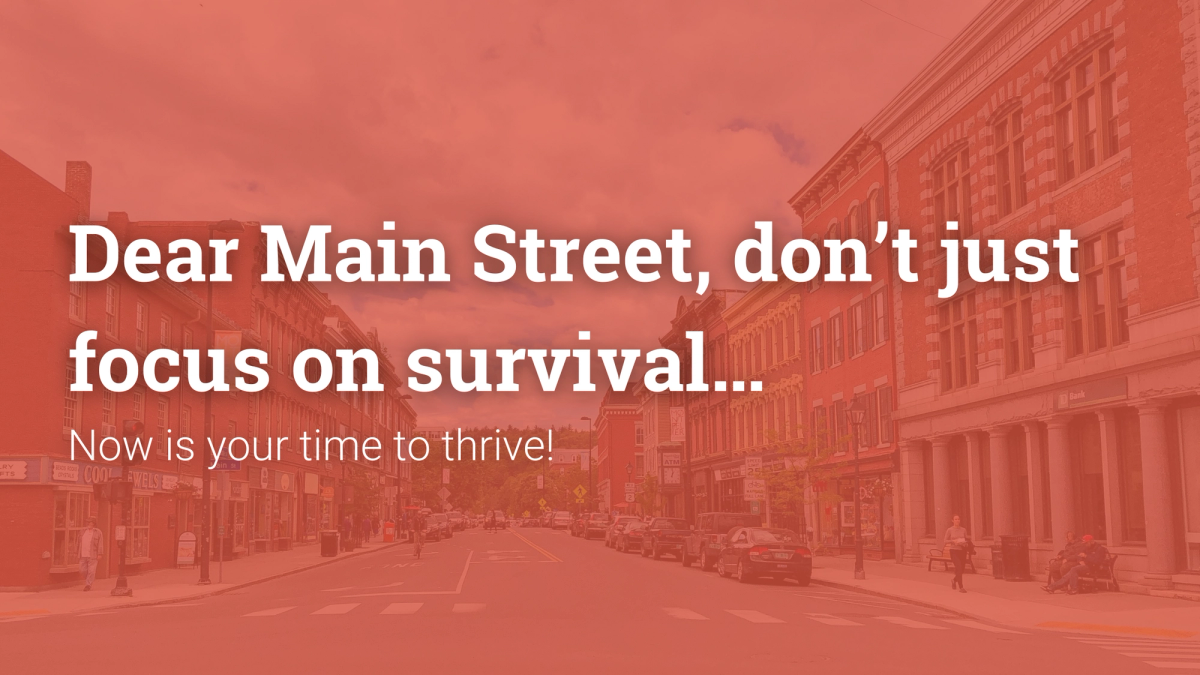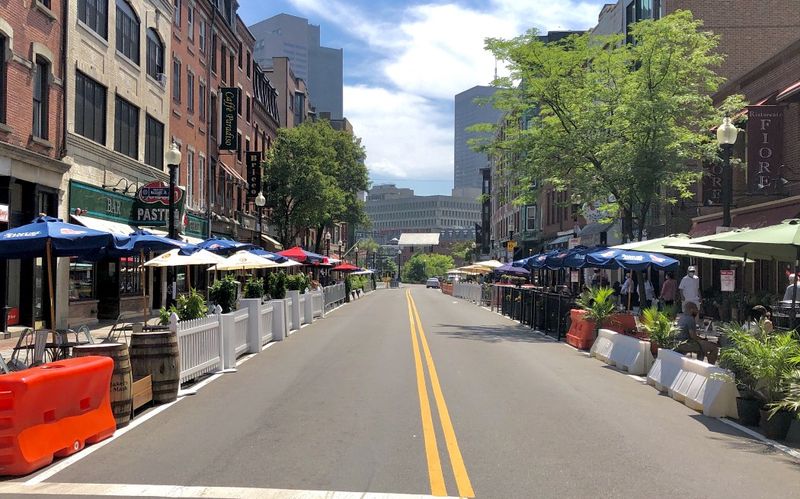
Dear Main Street, don't just focus on survival... Now is your time to thrive!
A look at the long-term solutions Main Streets can take to become the social, cultural, and local wealth engines we all know they’re capable of being.
The COVID-19 pandemic has disrupted almost everything in our daily lives and routines. It’s changed the way we work, if we’re still lucky enough to work at all right now. It’s changed the way we commute. It’s changed the way we shop and dine, the way we communicate, the way we workout and so much more. It’s taken friends and loved ones from us too early and has lead to sleepless nights and uncertainty for what the future might bring.
Today, Main Streets and commercial centers around the world are working to rapidly reinvent themselves in an attempt to extend a lifeline to their struggling small businesses. Open Streets, “streateries,” shared streets, expanded sidewalks, new bike lanes, and more, all in an effort to save the lifeblood of their local economies and the heart and soul of their communities.
I wrote a bit last Fall about a trend we were seeing shifting customers and investment away from traditional shopping malls and back into local commercial centers like Main Streets. During COVID-19, those trends are only rapidly increasing during a period where outdoor commerce is viewed as far safer than confined, indoor spaces like shopping malls. As Main Streets continue to innovate creative solutions to their reopening challenges, I propose that the aim shouldn’t just be immediate “survival” but also a look to the long-term on how Main Street can punch above its weight and become the social, cultural, and local wealth engines we all know they’re capable of being.
Before COVID - The Trends
In my previous post, “Why the Mall Will Inspire a Main Street Renaissance,” I go more in depth on how increased demands for walkable urban neighborhoods, coupled with an increase in cost of living in big cities and crushing congestion, present unique opportunities for Main Streets to attract new customers to area businesses and new residents to local commercial districts.
People are looking for more affordable housing while still demanding many of the things that make bigger city living attractive; walkability, community, vibrant public spaces, bars, restaurants, local stores, and neighbors. The ability to walk or bike to work, the grocery store, a park, cafes, school, or anywhere else you might want to go on a typical day in a short amount of time. That concept of "15-minute living," while not being a new one, is one that has taken Global prominence recently as the Mayor of Paris, Anne Hidalgo, made the concept a priority in her successful campaign for reelection just last month.
During COVID-19 - What were we missing…
During the early days of the pandemic and related lockdowns, many of us were sheltered in our homes, unable to visit our favorite businesses and public spaces. We missed the energy, the environment, neighbors, friends, relatives, and even the strangers that would become friends after chance encounters. Cities and towns have always been intended to foster gatherings and connectivity since the earliest days of the Ancient Greek agoras. Downtowns and Main Streets allow us to live in dense places, have happenstance meetings with people with diverse viewpoints, and from very diverse backgrounds, and are spaces to conduct commerce.
Reopening Post COVID - New Energy
Outdoor events and commerce present an opportunity to build a vibrancy and an energy that many haven’t seen for years on main street while being a needed lifeline to support area small businesses.

With outdoors over indoors being the name of the game for reopening strategies across the globe, there’s a chance to bring the energy of Main Street that typically exists largely indoors, outside again. This added energy can help encourage visitors to stop, stay, people watch or just engage with others in a more socially distanced setting as compared to indoor shopping malls or other facilities.
With more people working remotely and avoiding enclosed offices for the foreseeable future, typical commuters into larger metropolitan areas are now spending more of their time living and working in their hometowns. A daytime economy that was largely non-existent a few months ago is now an untapped opportunity for businesses struggling to survive. If the work-from-home trends continue into the new year, these opportunities could not just buoy existing businesses but also support new opportunities for different types of small businesses to start up on Main Street.
Obviously, it would be short-sighted to underestimate the dire straights many of our small businesses find themselves in financially after months of shutdowns and diminished capacities upon reopening. The immediate goal right now is to do everything in our power to support these businesses and ensure they can continue to be both the economic engines of our communities and the social stitching that knits the fabric of our communities together. Viewing this as an iterative process, that second goal is to not just ensure the survival of these businesses but use this time of rapid change to ensure that these businesses and Main Street districts THRIVE as we come out of our lockdowns and head into the next few years of a changed economy and adjusted lifestyles.
Creative Funding Opportunities Supporting Main Street Recovery
In Massachusetts, MassDOT’s "Shared Streets and Spaces" program was set up to help communities adapt their street spaces in response to the COVID-19 crisis allotting up to $300,000 per community, “to quickly launch or expand improvements to sidewalks, curbs, streets, on-street parking spaces and off-street parking lots in support of public health, safe mobility and renewed commerce in their communities.”
The UK has announced that, through the end of August, diners can receive 50% off their bill for eating dinner out on Monday through Wednesday in an effort to spur consumer spending on traditionally slow nights (up to £10 per diner), in an effort to help infuse capital into the struggling hospitality industry.
The tiny town of Frisco, Colorado has not only opened their entire Main Street to people and dining but also set aside $100,000 to give to residents as gift cards to be spent at any businesses along Main Street, up to a certain level.

In Michigan, the Michigan Economic Development Corporation, in partnership with our civic crowdfunding platform at Patronicity, established a crowdgranting program that allowed businesses across the state to raise up to $5,000 in crowdfunding dollars to be paired with $5,000 in matching grant dollars. Many of these businesses raised their share of the match by rewarding donors with gift cards and other businesses-related gifts, giving future patrons added incentives to visit the restaurant and support, not just during the lockdown but also in the months following as a new customer.
Importance of Rebuilding Community, Regenerating Local Economies
When you shop at a local business, a larger percentage of the dollars you spend there is reinvested in the local community, and, on average, more jobs will stay there. In addition, successful local businesses encourage others to be their own boss, follow their passions and create their own small businesses, growing a strong local, grassroots economy based in a strong entrepreneurial culture.
Inevitably, some businesses will shutter because of this crisis and vacancies will expand across our main streets. It’s important to look at these vacancies not as blights in a community but as spaces of opportunity for regeneration. Small business accelerator programs, incubators for startups, and free or low-cost workspaces will help bring more varied foot traffic while also providing a space for innovation and a focus on small business growth. Creating subsidized or affordable space for local retailers, chefs, artists and creatives will help build up the area’s cultural attractions to be even stronger than they were before this crisis. When you provide spaces for entrepreneurs and their employees who may have lost jobs due to closures to begin new ventures, you build local wealth and create a stronger and more unique identity for your community.
The coming months will be critical to determining which small businesses are able to survive and which Main Street districts are able to come through the other side of this pandemic in a position to succeed.
We all have a part to play in Main Street, from the municipal official who can streamline permitting for outdoor commerce to the chef looking to get back in the kitchen and do what they do best, the customers to return (safely) to their favorite local businesses and the local arts and cultural community to get creative over the coming months to continue to foster “community.” With this collective action and support of creative financing programs supporting the recovery, our Main Streets can truly come back stronger than ever to become the engines of local economies and the backbone of local communities that we know they can be.

